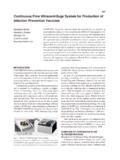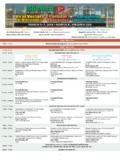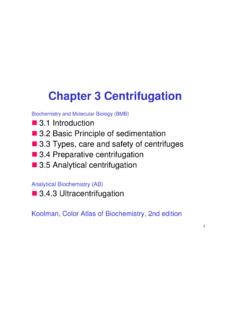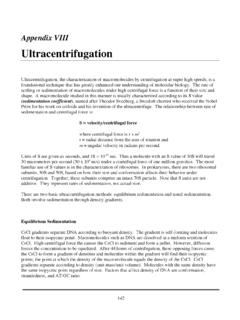Transcription of Effect of formaldehyde and binary ethyleneimine …
1 Rev. sci. tech. Off. int. Epiz., 1989, 8 (3), 747-764. Effect of formaldehyde and binary ethyleneimine (BEI) on the integrity of foot and mouth disease virus capsid RWEYEMAMU, O. UMEHARA, W. GIORGI, R. MEDEIROS, D. LUCCA NETO and M. BALTAZAR * Summary: formaldehyde treatment of foot and mouth disease (FMD) virus caused a statistically significant (p < ) reduction in the concentration of 140S particles (26-72%) for 5 of the 6 South American vaccine virus strains tested. formaldehyde also reduced the stability of the virus; after storage at 4 C for 6 months, there was a decay of 33-85% in the concentration of 140S particles. In contrast, samples treated with BEI did not undergo a significant reduction in 140S immediately after inactivation or after storage. The efficiency of infectivity inactivation by BEI was influenced by its concentration and temperature.
2 No significant reduction in 140S was observed at 36 C in 24 hours. KEYWORDS: Aphthovirus - Ethyleneimines - Foot and mouth disease - formaldehyde - Inactivation - Vaccines. INTRODUCTION It is commonly accepted that the immunogenicity of foot and mouth disease (FMD) vaccines is dependent on the presence of the intact capsid, as either the nucleocapsid with a sedimentation rate of 140S or the natural empty particle which sediments at 75S (10, 15, 20, 37, 40, 44). For the majority of strains, the principal immunogenic component is the 140S particle. Several studies have shown a direct relationship between the dose of 140S antigen in vaccine lots and the rate, height and persistence of virus neutralising antibody in cattle after both primary and secondary vaccination (8, 9, 29, 30, 34, 39). Hence many modern FMD vaccine manufacturing establishments include the quantification of 140S antigen in the battery of quality control tests during production (5, 21, 22, 26, 31, 34, 38, 42).
3 There are conflicting reports in the literature on the Effect of commonly used virus inactivators, formaldehyde and aziridine compounds, on the integrity of FMD virus capsid and thereby on immunogenicity. formaldehyde has been largely discredited as an inactivator, mainly because of non-linear inactivation kinetics leading to residual infective virus which, sometimes, is detectable for several weeks after completion of * Pfizer International Inc., Laboratorios Pfizer Ltda., Rodovia Presidente Dutra Km 225, CEP 07010 Guarulhos, S o Paulo, Brazil. 748 the "inactivation" period of 48 hours (12, 19, 41). There have been several instances of FMD outbreaks considered to have been associated with the use of formaldehyde -inactivated vaccines (7). In contrast, the aziridine compounds acetylethyleneimine (12), ethyleneimine (17) and binary ethyleneimine (3) have been associated with first-order virus inactivation kinetics and have, generally, resulted in innocuous vaccines.
4 Such compounds fulfil a recent recommendation by the OIE for inactivated FMD vaccines (33). Nevertheless, some reports in the literature have claimed that both formaldehyde (27) and aziridine compounds (36) are able to destroy the FMD virus capsid and thereby reduce vaccine immunogenicity. At Pirbright (32, 36), a hybrid inactivation procedure involving sequential treatment of virus with formaldehyde and AEI was devised in order to preserve the 140S particle. As far as we know, the method is not widely employed by FMD vaccine manufacturers. In the present study we investigated the Effect of formaldehyde and binary ethyleneimine on South American strains of FMD virus capsid when the compounds were used either singly or in sequence. MATERIALS AND METHODS Virus strains The strains of FMDV used in this study were all of South American origin: O Campos/Brasil-58, A Cruzeiro/Brasil-55, A Venceslau/Brasil-76, A Bag /Brasil-76, A Castellano/Argentina-87 and C Indaial/Brasil-71.
5 They had been adapted to growth in BHK suspension cells (14) for vaccine production. For this study each virus was grown in BHK suspension cells either in a spinner culture of 2 litre volume or in a 3000 litre fermenter. Virus was harvested at maximum cytopathic Effect ( ), usually after 16 to 24 h. Inactivation with formaldehyde The virus suspension was adjusted to pH with glycine buffer and a temperature of 26 C in a water-bath fitted with a magnetic stirrer. Then 1:10 formalin in distilled water was added to the virus suspension to a final concentration of v/v formalin. Periodically the virus-containing flask was manually inverted in order to bring virus in the air space above the liquid level (less than 10% of total flask capacity) into contact with inactivator. Inactivation proceeded for 48 h under magnetic agitation. Inactivation with BEI The procedure adopted was similar to that described by Bahnemann (3).
6 BEI was generated by treating 2-bromoethylamine hydrobromide with NaOH for 1 hour at 37 C. This solution was then added to the virus suspension to give the desired concentration of BEI, 1% v/v for 1mM BEI; 2% v/v for 2mM BEI, etc. Periodically, the virus-containing bottle was inverted in order to inactivate virus in the air space above the liquid level. Temperature and time of inactivation were as specified under "Results". Excess BEI was neutralised at the end of the inactivation period with w/v sodium thiosulphate. 749 Inactivation kinetics and innocuity testing For measuring inactivation kinetics, samples were collected at hourly intervals up to 4 h after adding inactivator. The inactivator was neutralised and samples titrated for surviving virus infectivity by using the microcolour test (28). The kinetics constant, slope and half-life were calculated.
7 At 24 and 48 hours after commencement of inactivation, samples were collected for innocuity testing. After neutralisation, each sample was inoculated onto duplicate Roux flasks of BHK monolayers maintained on a serum-free medium. The cultures were examined for and complement fixing antigen over three serial passages (2, 16). Quantification of 140S Test virus samples were first concentrated tenfold by using saturated ammonium sulphate either at 4 C overnight or at room temperature (ca. 25 C) for two hours, and resuspended in phosphate buffer. Then the concentration of the 140S particles was assayed by sucrose density gradient using the methods of Barteling and Meloen (5) and Doel et al. (21). Briefly, the sample was treated with (w/v) bovine ribonuclease at 36 C for 10 min to degrade any free RNA or ribosome, and then 1 ml of this was layered onto a preformed, linear 10-30% (w/v) sucrose density gradient.
8 The gradients were centrifuged at 40,000 rpm using the Beckmann SW 41 Ti rotor in the Beckmann L8-55M ultracentrifuge for 60 min. Then the gradients were scanned at 259 nm wavelength using the Beckmann DU-7U spectrophotometer fitted with a continuous cm pathlength flow-cell. The area under the peak was calculated and used to determine the concentration of 140S particles using the following formula: 140S g/ml = FRxPAxFSDxlOOO SxPLxExWx 10 where FR = flow rate in ml/min PA = area under the peak in cm2 FSD = full scale absorbence optical density unit setting S = speed of the chart recorder in cm/min PL = pathlength of the flow cell in cm E = extinction point for FMDV, at 259 nm W = sample volume (ml) applied to gradient ( value divided by 10 to allow for the concentration factor) Under our conditions the method gives a coefficient of variation of 12% for inter-test and 5% for intra-test variation.
9 Statistical analysis The statistical analysis of data was carried out using the RS/1 programme of BBN Software Products Corporation (Cambridge, USA) operating in the DOS mode of IBM on the Microtec XT 2002 microcomputer. The level of rejection of the null hypothesis was set at 750 RESULTS Lot no. Live virus Formalin Formalin/BEI BEI ImM xl/26 C/48h 26 C/48h x2/26 C/48h 1 2 3 4 5 Mean STDEV SEM Anova oneway: p = TABLE lb Effect of inactivators on concentration of 140S antigen (ng/ml) in vaccine virus harvests of strain A Cruzeiro Lot no. Live virus Formalin Formalin/BEI BEI ImM x l/26 C/48h 26 C/48h x 2/26 C/48h 1 2 3 4 5 6 Mean STDEV SEM Anova oneway: p = Two series of experiments were carried out.
10 In the first the virus harvest was divided into four lots: one lot was inactivated with formaldehyde ( v/v formalin); the second was inactivated with two doses of 1mM BEI 24 hours apart; the third was treated for the first 24 hours with formaldehyde and then, additionally, with 1mM BEI; the fourth lot was left as a live virus control. The pH of all 4 lots was adjusted to pH and they were all incubated under agitation in the same water-bath at 26 C for a total of 48 hours. For each virus strain 4-6 replicate tests were thus carried out. The results of this set of experiments are summarised in Table I a-d and Figure 1, from which it is evident that the reduction in 140S level due to BEI treatment was less than 25% and statistically insignificant for any of the tested strains. In contrast, formaldehyde , either alone or in combination with BEI, reduced 140S by up to 72%.
















